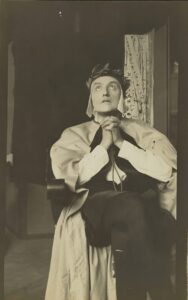“The papers of Violet Oakley contain primary sources that reveal some of what she required of her models. She called on her friend, the illustrator Mills Thompson, as she prepared the stained glass Dante Window. (The Smithsonian American Art Museum owns a scale model; the work is in the Apostolic Nunciature of the Holy See to the United States.) Draped in cloth resembling Renaissance garb, donning a laurel wreath, and wearing a prosthetic nose, Thompson posed for a series of reference photographs that Oakley used in creating the window which was based on the Dante Alighieri’s fourteenth-century poem The Divine Comedy.
[. . .]
“Like the epic poem, the window is divided into three parts with four medallions each: the left panel represents the Inferno, (meant to be read from top to bottom), the right panel, Purgatorio, (read from the bottom), and the center section, Paradiso (also read from the bottom). In this group of twenty photographs, an animated Thompson personifies the character of Dante as he ponders, prays, attempts to ward off beasts, travels through Hell and Purgatory with Virgil, and ascends to Heaven with Beatrice. (Henrietta Cozens, who likely posed as Virgil for the image in medallion two of the Purgatorio panel, is not quite as vigorous in her expression.)” —Elizabeth Botten, “Models and the Making of Violet Oakley’s Dante Window”, Smithsonian Blog, June 17, 2014 (retrieved February 29, 2024)



